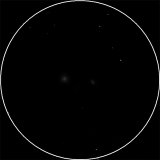
| MESSIER 105 |
|---|
RA: |
10h 47m 48s |
|
DEC: |
+12° 35' 00'' |
|
Type: |
Elliptical galaxy |
|
NGC: |
3379 |
|
Magnitude: |
9.30 |
|
Surface brightness : |
12.80 |
|
Apparent dimensions : |
5.3'x4.8' |
|
Distance: |
38,000,000 ly |
|
M105 was discovered by Pierre Méchain on March 24, 1781, even 3 days earlier than M101, but due to unknown reasons, although probably intended, not included in Charles Messier's published list. Méchain described this object in his letter of May 6, 1783. This additional object was included in the Messier Catalog by Helen B. Sawyer Hogg in 1947, together with M106 and M107. William Herschel had observed it on March 11, 1784, and assigned it his number H I.17. M105 is the brightest elliptical galaxy in the Leo I or M96 group of galaxies, and as such approximately 38 million light years distant. It is of type E1, and often studied as a typical representative of elliptical galaxies. Investigations with the Hubble Space Telescope of the central region of M105 have revealed that this galaxy contains a massive central object of about 50 million solar masses. |
||
VEDRAN VRHOVAC© 2006.-2007. |
